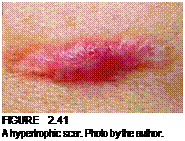After an injury and a wound heals, scars, which are areas of fibrous tissue that replace normal skin, form. With the exception of very small cuts or abrasions, every wound results in scarring to some degree. Scar tissue is quite different from the skin tissue it replaces. For example, hair follicles do not grow back in scar tissue, so that information is necessary in creating a scar effect as part of a makeup design. Scars are part of the natural healing process and as such need to be understood to create authentic scar makeup. Obviously, the greater the damage to the skin, the greater the scar will be. Most scars are flat and pale and leave a mark of the original injury.
As wounds heal, they go through changes. The initial redness that follows a skin injury is not a scar; it may take days or weeks for the redness to go away and to go from wound to scar, and if you are doing a progressive makeup, the stages of
a wound are important to know. Wound makeups as well as burns and skin diseases are discussed in Chapter 9.
 Two types of abnormal scar result from the body’s overproduction of collagen. This causes a raised scar above the surrounding skin.[24] Hypertrophic scars take the shape of a raised red lump on the skin but don’t grow beyond the boundaries of the original wound. They often improve in appearance over time, usually a few years.
Two types of abnormal scar result from the body’s overproduction of collagen. This causes a raised scar above the surrounding skin.[24] Hypertrophic scars take the shape of a raised red lump on the skin but don’t grow beyond the boundaries of the original wound. They often improve in appearance over time, usually a few years.
Keloid scars are a more serious form of scarring. Keloids are capable of continuing to grow indefinitely. Both hypertrophic and keloid scars are more common on younger and darker-skinned people.
Keloid scars are most commonly seen on the shoulder, chest, and abdomen and are most common among people of Asian or African descent.
Alternately, a scar can take the form of a sunken recess in the skin that has a pitted appearance. These are caused when the underlying structures supporting the skin, such as fat tissue or muscle, are lost. This type of scarring is most typical of acne scars but can be caused by diseases such as chickenpox also. Stretch marks, mentioned earlier in this chapter, are a form of scarring as well.[25]
